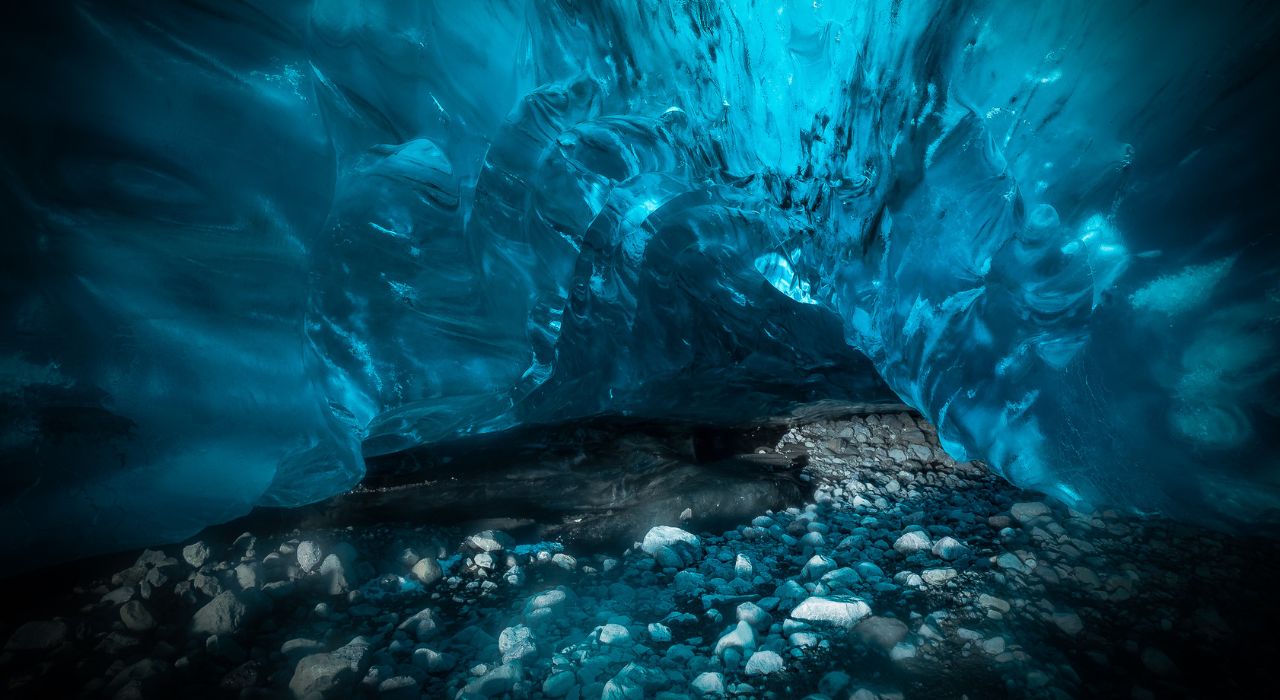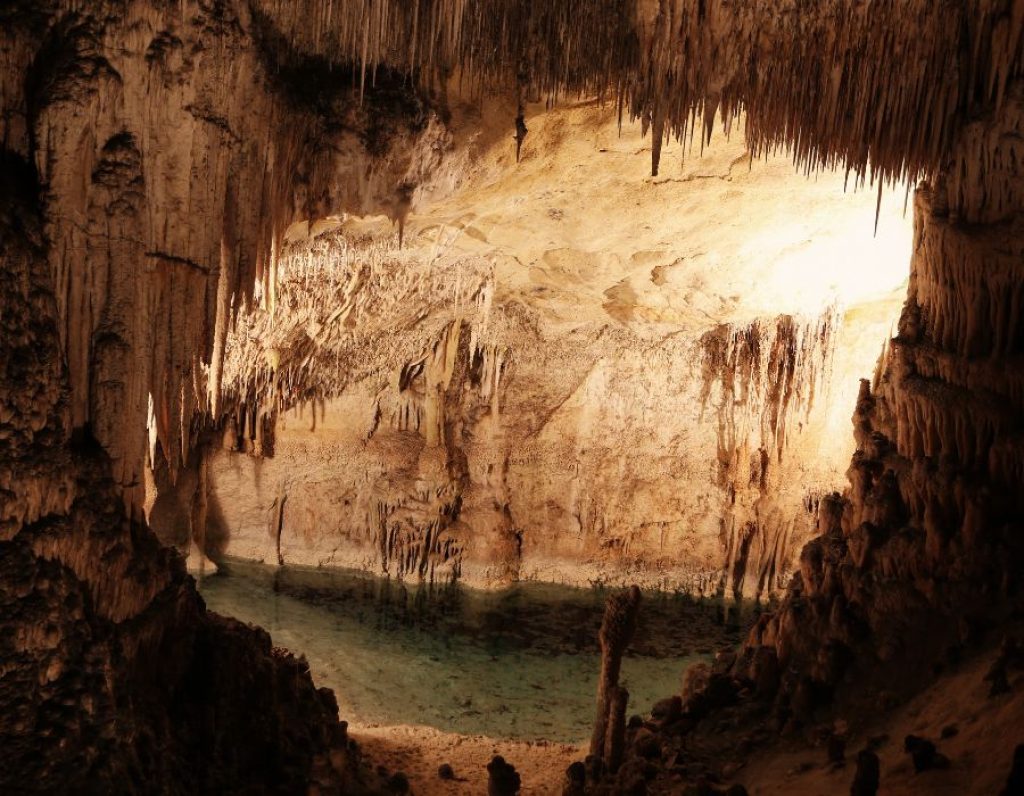
IOGRAPH CAVE
On the slope of Ai-Petrinskaya Yayla, there is the Iograph Cave. The cave has only one large hall and several narrow passages. The entrance to the cave is masked by limestone, and from the path, which runs a stone’s throw away, the entrance is difficult to see. Iograph – karst cave. Inside, there are many sinter formations, stalactites and stalagmites.
But in addition to natural interest, if there is historical interest in the cave. In the 8th-9th centuries, the cave Christian church of the Holy Martyr Evgraf functioned in the cave. Then, the Turks organized persecution of Christians on the peninsula, so believers had to go to the mountains.
When researchers first got into the Iograph cave, they discovered there the fragments of an ancient marble icon on which the Face of Jesus Christ was preserved. In addition to this relic, the remains of lamps, an iron cross, and all kinds of glass and copper decorations were found. An interesting fact is that no matter how hot it is outside, clean and transparent drops of water always fall from the stalactites onto the stone altar.
In the 19th century, the cave was abandoned and littered. The cave acquired the status of a natural monument only in 1947. But the cave was cleared of debris only in the 90s, and by enthusiasts. They hung several icons at the entrance. The first service was held here in 1997. Therefore, today the Iograph Cave is not only a natural, but also a cult landmark of Crimea.
BOTTOMLESS CAVE

The Bottomless Cave is sometimes called the Bottomless Well and the Bottomless Mine. Technically, this is a combination of the shaft that opens the cave and the cave itself. This is a vertical cave about 195 meters deep, the entrance to which is at an altitude of almost a kilometer. The length of all cave passages is 410 meters.
The cave begins with a 17-meter staircase. Next comes the neck of the mine, 5 meters wide. Further, the cave expands to 25 meters. It is always cool at the bottom of the mine, so an ice cone up to 10 meters in height often grows at the bottom. Three branches go off to the sides from the bottom. One goes steeply up to a height of 30 meters. The other is the bed of a dry underground stream. Along it, you can go to a 15-meter deep well and two more small halls. Visiting the cave is very dangerous; you must have special training and the necessary equipment.
THREE-EYES CAVE

The entrance to the cave consists of 3 large holes, similar to eye sockets. That is why she is called Three-Eyes. The temperature inside is close to zero at any time of the year. The floor in the cave consists of a several-meter layer of ice that does not melt. The huge snowdrift, which has become a local landmark, does not melt either. A cone-shaped snowdrift is located right in the middle of the cave. Now, it has become popular to insert coins into a snowdrift.
In ancient times, hunters left their trophies in this cave because it served as an excellent refrigerator. Since the cave is quite deep, food was lowered into it on a rope; when it was needed, it was also raised. Later, Count Vorontsov used the cave to cool his wines. Ice from the cave was delivered in wooden tubs down the slope to the count’s estate.
For some time, the cave stood abandoned and littered. But now it has been exalted and is again one of the main attractions of Ai-Petri. Unfortunately, active mismanagement of human activity has led the Three-Eyes Cave to a deplorable state.
YALTA CAVE

The “Yalta” cave is located very close to the “Three-Eyes” cave, a little closer to the cable car stop. It was opened quite unexpectedly in 1997. It was discovered by the son of a Yalta cave explorer and climber while picking mushrooms on the Ai-Petri Plateau. Stones and leaves disguised the entrance to the cave. Behind a small opening, a huge hall with beautiful stalactites opened up. The height of the hall from the floor to the top of the dome was 18 meters.
Speleologists examined the “Yalta” cave and preserved it. Over time, the entrance became littered. Ten years after the first visit to the cave, people entered it again. In 2007, three speleologists used their savings to restore and clear the entrance to the closed cave. They provided lighting and laid out an excursion route. Although the “Yalta” cave is small and the inspection takes a little time, nevertheless, the visit is informative and interesting. Here, you can see stalagmites and stalactites, as well as stone flowers and pretty sinter formations.
RED CAVE (KIZIL-KOBA)

The “Red” Cave is carefully protected and is part of the national heritage. The formation of the “Red” cave is typical for similar caves of karst origin. This is a long process where water erodes and dissolves the limestone. “Kizil-Koba” means “Red Cave” translated from Tatar. In the gorge in which the cave is located, the red tint of the slopes predominates.
This is the largest cave on the Crimean Peninsula, and is the largest karst cavity in Eastern Europe, lying deep in limestone rocks. To date, 21.5 kilometers of the Red Cave have been explored. Its approximate area has been determined – it is 64 thousand square meters, and its volume is amazing – 270 thousand cubic meters. The difference in the height of the Red Cave also has no equal in Europe – 275 meters.
At the moment, six levels have been explored in the cave. In some places, the Red Cave is decorated with long stalactites, stalagmites, corallites, drapery and fringe. A fast river meanders along the cave bottom, which, breaking out to the surface, forms a wonderful waterfall called Su-Uchkhan. The microclimate in the cave does not change throughout the year; the average air temperature is about 9 degrees Celsius.
As a result of research, archaeologists in the Red Cave found many ceramic products from the 7-6 centuries BC, as well as bronze arrowheads, rings, beads and bracelets. In a clearing near the caves, a human dwelling, 2500 years old, was discovered. Further excavations showed that there was an entire settlement of a culture unknown to science, which was called “Kizil-Kobinskaya”, after the name of the gorge and cave. The Red Cave was likely a family sanctuary where animal sacrifices took place. Since 1989, an equipped expedition route with a length of 500 meters has been constantly operating in the “Red” cave.
SKELSKAYA CAVE
The local teacher, E. Kirillov, walked through the Skelskaya Cave for the first time in 1904, and since 1964, the Skelskaya Cave has been protected by law as a natural monument. The length of the explored passages is 670 meters.
The cave was formed as a result of tectonic processes and the action of groundwater flowing several million years ago in limestone layers. As a result of natural phenomena, the upper vault collapsed, and a large hall was formed, which was subsequently divided into smaller rooms by sinter formations. In the Skelskaya cave, many bones of extinct animals were found: the Crimean saiga, forest cat and others. Well-preserved calcite sinter formations also distinguish the cave. Skelskaya Cave has three levels and several halls.
Traditionally, the cave is divided into several halls. The first hall of the Skelskaya Cave is called the “Fireplace Hall” since the influx is very reminiscent of a fireplace. Here is also a kind of guardian of the cave – a solid stalagmite. The second platform is the most beautiful and largest of the halls. The length of the hall is 80 meters, the width is 10-18 meters, and the vault height is 25 meters.
The third hall is the Knights’ Hall, which received its name because of a seven-meter stalagmite resembling a knight with a spear. This is the most remarkable place in the entire Skelskaya Cave. The fourth platform is called the Hall of Ghosts. The 25-45-meter wells starting here connect several upper halls of the Skelskaya cave with the forming lower floors. The lower narrow galleries are unique in that rivers flow through them, forming underground lakes with a depth of 70 meters. These rivers and lakes supply water to the Baydar Reservoir.
The cave is included in the Crimean Book of Records because it is home to a huge number of insects and mammals that are found only in this cave. Skelskaya Cave is located 350 meters above sea level. In the upper halls the temperature is constantly around 12 degrees, and in the lower halls – 9 degrees. Water temperature – 8 degrees.
SOLDIER’S CAVE
At an altitude of about 980 meters above sea level, there is the Soldier’s Mine, as this cave is also called. This is the most difficult cave to navigate on the peninsula, the deepest and third longest in Crimea. The length of the cave is 2.1 kilometers, its depth is 517 meters, its area is about 4.3 thousand square meters, and its volume is approximately 16.3 thousand cubic meters. The air temperature near the bottom of the cave is 3 degrees colder than at the surface. At a depth of 435 meters, the cave contains small lakes and streams.
The cave received its name in 1969 from the discoverers from the Feodosia speleological club “Kara-Dag”. They found a strange crack filled with stones. Behind the rubble, there was a passage, and after 200 meters, there was a vertical well. Only in 1971, it was discovered that the cave was about 500 meters deep.
At a depth of 340 meters there is the “Nadezhda” well, 85 meters deep. A small stream flows along its ledges. The well ends in a narrow crack, about 380 meters long, along the bottom of which water flows. The temperature of the bottom water flow is 9.1 degrees. In 1993, environmentalists cleared the cave of debris. In 2010, a door was installed at the entrance. The exploration of the cave is not finished.
SNAKE CAVE

The Snake Cave is a rather interesting place. This karst cave became a natural monument of Crimea in 1969. The length of the cave is 350 meters, and the total area is 400 square meters. The cave got its name because of its narrow winding passages. However, there were some legends. One of them says that a dragon used to live in the cave. But no traces of any large animals, nor snakes, were found here. But there are a lot of bats here, including a large horseshoe bat, listed in the Red Book. Bats are not dangerous to people.
The cave consists of three floors. Only the lower and middle levels are well preserved. The lower floor is beautiful, with inclusions of calcite. Archaeologists have discovered multiple remains of the Kizil-Koba culture. According to scientists, there was a family sanctuary here. In the depths of the cave, archaeologists found a mass of bones and skulls of animals that were sacrificed, as well as shards of ceramics.








